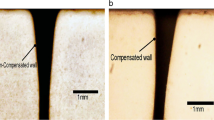Abstract
With the application of the 5-axis abrasive water jet (AWJ) machining center, some shape errors, such as cock tail striation, taper, etc., have been removed successfully, and the cutting precision has been improved greatly. However, the shape error located in the cut-in/cut-out region is still a big issue in AWJ cutting process. It often leads to the result that parts cut by AWJ becomes unacceptable. Based on theoretical analysis of the shape error in this region, it is found that the mathematical model used in 5-axis AWJ machining to compensate taper is often built on cutting data within normal cutting speed range. Therefore, the mathematical model becomes inaccurate in cut-in/cut-out regions, where very low cutting speeds are used. To solve this issue, a method of adding an extra nozzle tilting angle is proposed in this paper. This method has been proved to be effective through a series of experiments. With this method, the cutting precision could be improved not only in cut-in/cut-out regions, but also in corner regions where very low cutting speeds are used.
Similar content being viewed by others
Change history
19 December 2018
The article Correcting shape error located in cut-in/cut-out region in abrasive water jet cutting process, written by Ming Chen, Shijin Zhang, Jay Zeng, and Binghai Chen
References
Hashish M (2015) Waterjet machining process. In: Nee AYC (ed) Handbook of manufacturing engineering and technology. Springer, London, pp 1651–1686
Krajcarz D (2014) Comparison metal water jet cutting with laser and plasma cutting. Procedia Eng 69:838–843
Yuqiang W et al (2015) Method of obtaining accurate jet lag information in abrasive water-jet machining process. Int J Adv Manuf Technol 2015 76(9–12):1–9
Zeng J, Henning A (2009) Kerf characterization in abrasive waterjet cutting. In: Proceedings of the 2009 American waterjet conference, Houston, Texas. August 18–20, paper 1-H
Liu JX, Ma QC (2009) Comparison and application of cut-in/cut-out method in 2D profile NC Milling. Mech Eng 2009(6):50–51 (Chinese)
Huan N, Zhang XF, Jin Y (2012) Design of Planar Contour Parts Cutting-into and Cutting-off Method in NC Milling. Mach Tool Hydraul, 2012 40(18):70–71 (Chinese)
Hashish M (2006) Enhanced abrasive waterjet cutting accuracy with dynamic tilt compensation. CRIP 2nd international conference on high performance cutting, Vancouver, British Columbia, Canada. June 2006:12–13
Zeng J, Heines R, Kim T J (1991) Characterization of energy dissipation phenomenon in abrasive waterjet cutting. Proceedings of the 6th American waterjet conference, Houston, Texas, USA 1991:163–177
Zhang S (2011) An investigation of surface quality cut by abrasive water jet. Open Mech Eng J, 2011 5(1):166–177
Zeng J, Kim T J, Wallace R J. (1992) Quantitative evaluation of machinability in abrasive waterjet machining. 1992 Winter Annual Meeting of ASME, “Precision Machining: Technology and Machine Development and Improvement,” PED-Vol58, Anaheim, 1992:169–179
Hashish M. (2004) Precision cutting of thick materials with AWJ.In: BHR group 2004 water jetting, pp 33–46
Matsui S, Matsumura H, Ikemoto Y, Tsujita K, Shimizu H. (1990) High precision cutting method for metallic materials by abrasive waterjet. Proceedings of the 10th international symposium, Amsterdam, 1990:263–278
Chung Y, Geskin ES, Singh PJ (1992) Prediction of the geometry of the kerf created in the course of abrasive waterjet machining of ductile materials. Jet cutting technology. Springer Netherlands 1992:525–541
Groppetti R, Gutema T, Lucchio AD (1998) A contribution to the analysis of some kerf quality attributes for precision abrasive waterjet cutting. The 14th international conference on jetting technology. Brugge, Belgium 1998:253–269
Annoni M, Monno M, (2000) A lower limit for the feed rate in AWJ precision machining. Proceedings of the 15th international conference on jetting technology, Ronneby, 2000:285–296
Shanmugam DK, Wang J, Liu H (2008) Minimisation of kerf tapers in abrasive waterjet machining of alumina ceramics using a compensation technique. Int J Mach Tools Manuf, 2008 48(14):1527–1534
Hlaváč LM, Hlaváčová IM, Geryk V, Plančár Š (2014) Investigation of the taper of kerfs cut in steels by AWJ. Int J Adv Manuf Technol 77(9–12):1811–1818
Hlaváč LM, Hlaváčová IM, Geryk V (2017) Taper of kerfs made in rocks by abrasive water jet (AWJ). Int J Adv Manuf Technol 88(1–4):1–7
Wang S, Zhang S, Wu Y, Yang F (2017) A key parameter to characterize the kerf profile error generated by abrasive water-jet. Int J Adv Manuf Technol 90(5–8):1265–1275
Wang S, Zhang S, Wu Y, Yang F (2017) Exploring kerf cut by abrasive waterjet. Int J Adv Manuf Technol 93(5–8):2013–2020
Wang Shu. (2017) Study on Kerf Characterization of Thick Materials Machined with 3D Waterjet Precision Cutting, Dissertation
Zeng J (1992) Mechanisms of brittle material erosion associated with high pressure abrasive waterjet processing - a modeling and application study, Dissertation
Hlaváč LM et al (2015) Improvement of abrasive water jet machining accuracy for titanium and TiNb alloy. Int J Adv Manuf Technol 80(9–12):1833–1740
Funding
This research was supported by the National Natural Science Foundation of China (51675320).
Author information
Authors and Affiliations
Corresponding author
Additional information
The original version of this article was revised: Retrospective Open Access cancellation.
Rights and permissions
About this article
Cite this article
Chen, M., Zhang, S., Zeng, J. et al. Correcting shape error located in cut-in/cut-out region in abrasive water jet cutting process. Int J Adv Manuf Technol 102, 1165–1178 (2019). https://doi.org/10.1007/s00170-018-3123-2
Received:
Accepted:
Published:
Issue Date:
DOI: https://doi.org/10.1007/s00170-018-3123-2



